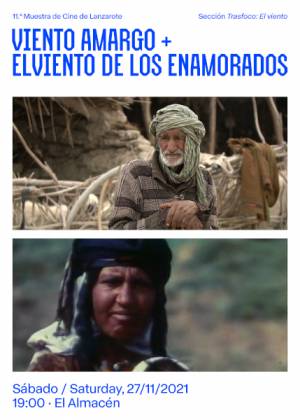Viento amargo + El viento de los enamorados - XI MCL
Elige sesión
Evento

XI Muestra de Cine de Lanzarote
Viento amargo + El viento de los enamorados - XI MCL
Viento Amargo
El viento del noreste, uno de los más fuertes que se producen en Irán, es conocido como «el viento de los 120 días de Sistán», y alcanza velocidades de hasta 120 kilómetros por hora. Se origina en las llanuras del Palmir y en los desiertos de Herat; entra por el Este del país, en la zona de Afganistán, y por lo general sopla entre mayo y agosto. Este viento genera grandes erosiones en la superficie de la tierra y mueve grandes cantidades de arena. Debido a estos fuertes vientos y al secado del lago Hamoon en la última década, numerosas aldeas de Sistán han quedado sepultadas bajo la arena y sus habitantes han migrado a otros territorios. En los últimos años, los habitantes de la región han comenzado a referirse a este viento como el «viento amargo».
———
The northwest wind is one of the strongest in Iran and is known as “the 120-day wind of Sistan”, reaching speeds of up to 120 kilometres per hour. It originates in the plains of Palmir and the deserts of Herat; it enters the country from the east, from the area of Afghanistan, and generally blows from May to August. This wind causes great erosion on the surface of the land and moves large quantities of sand. Due to the strength of the wind and the evaporation of Lake Hamun over the last decade, many villages in Sistan have been buried beneath the sand and their inhabitants have had to migrate to other areas. In recent years,
the people of the region have begun to refer to it as the “bitter wind”.
El viento de los enamorados
¿Qué pasaría si el viento no fuese en realidad un fenómeno meteorológico? ¿Si no fuese tan sólo el aire en movimiento generado por distintas presiones y temperaturas? ¿Y si el viento fuese en realidad un dios, o mejor aún, muchos dioses? Entonces, si así fuese, existirían dioses terribles y enfurecidos, capaces de llevarse por delante, con su ira y su enfado, casas, árboles y cultivos. Pero habría también dioses amables, es decir, vientos apacibles capaces de suavizar las temperaturas y llegar cargados de humedad en los tiempos de sequía. Y existirían también, cómo no, vientos o dioses generosos, que se encargarían de transportar las semillas de un lugar a otros y de acompañar a las aves en sus largas migraciones, para facilitarles el trayecto. En Irán, cuentan algunos, que esos dioses existen.
———
What if the wind were not in fact a meteorological phenomenon? What if it were not just air in movement generated by differences in pressure and temperature? What if the wind were really a god, or better still, many gods? If this were the case, that would mean that there would be terrible gods whose anger and rage are able to sweep all before them… houses, trees and crops. But there would also be kindly gods, like those pleasant winds able to cool temperatures and bring humidity in times of drought. And, of course, there would also be generous gods or winds, that transport seeds from one place to another and accompany birds on their long migrations, helping them along their way. In Iran, some people believe that these gods exist.